Top 12 Supply Chain Visibility Tools to Watch in 2025
- Matthew Amann
- Jul 4
- 15 min read
In today's volatile global market, knowing where your shipments are is just the starting point. True competitive advantage comes from predictive, real-time, and actionable data that turns your supply chain from a cost center into a strategic asset. The shift from reactive problem-solving to proactive optimization is critical, and the right technology is the linchpin. This guide moves beyond generic marketing claims to provide a detailed breakdown of the 12 leading supply chain visibility tools for 2025.
This comprehensive resource is designed to help you find the best platform for your specific needs, whether you're an infrastructure project manager synchronizing complex logistics or a technology firm integrating software ecosystems. We cut through the noise to deliver an honest assessment of each solution's core capabilities, ideal use cases, integration challenges, and potential limitations.
Inside, you will find a structured analysis of each tool, complete with screenshots and direct links, to help you make a well-informed decision. We focus on practical applications and real-world performance, providing the clarity needed to select a platform that can genuinely transform your operations and deliver a tangible return on investment. Let's explore the systems that provide the end-to-end transparency necessary to compete and win.
1. project44
project44 positions itself as a leader in high-fidelity supply chain visibility, offering a comprehensive platform that connects and tracks shipments across all major transportation modes. What sets it apart is its vast, high-quality carrier network and its focus on providing a single source of truth, from over-the-road and rail to complex international ocean and air freight. This platform is one of the most powerful supply chain visibility tools for enterprises needing end-to-end transparency.
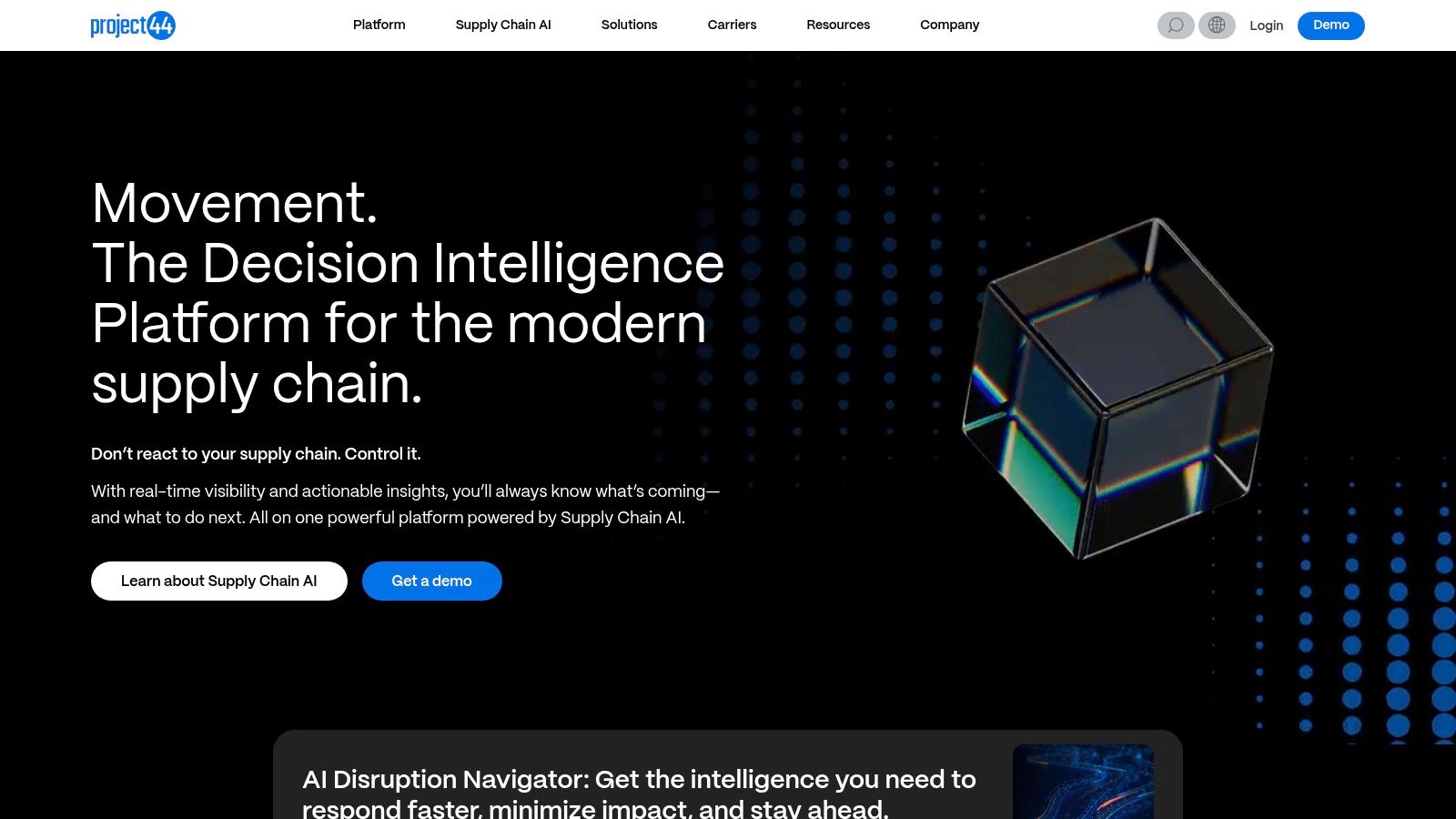
Its strength lies in transforming disparate data points into actionable intelligence. For instance, a logistics director can use project44’s predictive analytics to foresee a port congestion delay and proactively reroute an incoming ocean container to a less-congested port, saving both time and demurrage fees. This proactive capability is a cornerstone of modern logistics, aligning with the principles outlined in our guide on supply chain management best practices.
Key Information & Use Cases
Ideal User: Best suited for large enterprises with complex, multi-modal, and global supply chains that require robust data integration and predictive ETAs.
Pricing: Custom quote-based, reflecting the enterprise focus. Pricing depends on shipment volume, modes of transport, and the number of integrations required.
Implementation: Expect a structured implementation process that may require dedicated IT and project management resources due to deep integration with existing TMS, ERP, and WMS systems.
Pros: Exceptional data quality and network coverage; powerful predictive analytics.
Cons: The platform's extensive features can be overwhelming and costly for small to medium-sized businesses.
Visit the website: [https://www.project44.com/](https://www.project44.com/)
2. FourKites
FourKites champions real-time transportation visibility, leveraging an extensive network and machine learning to deliver precise ETAs and proactive exception management. Its core strength lies in its collaborative network, which not only tracks assets but also connects shippers, carriers, and brokers on a single platform to resolve issues collectively. This focus on network collaboration makes it one of the most dynamic supply chain visibility tools for companies that prioritize partner alignment and operational agility.
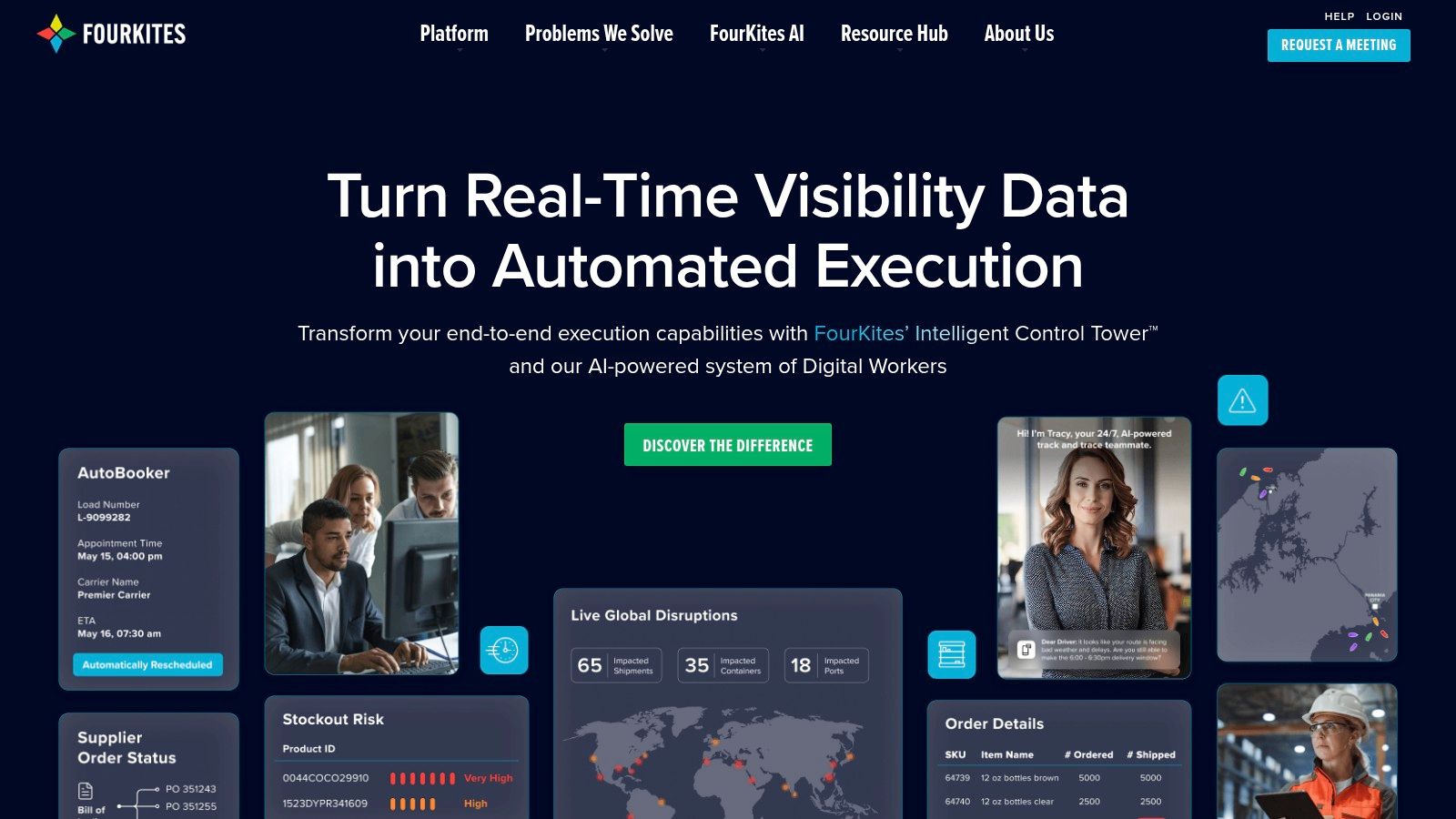
The platform translates real-time data into measurable improvements in efficiency and customer satisfaction. A distribution manager, for example, can use FourKites to monitor an inbound truck, receive an alert about an unexpected delay due to traffic, and automatically notify the receiving warehouse and the end customer. This instant, automated communication prevents dock congestion and manages customer expectations, improving on-time delivery performance and reducing operational friction.
Key Information & Use Cases
Ideal User: Best for large-scale shippers and logistics service providers who require deep, real-time visibility and collaborative tools to manage a diverse network of transportation partners.
Pricing: Enterprise-level custom pricing. The cost is based on factors like shipment volume, modes covered, and the number of facilities and users onboarded.
Implementation: The setup process varies based on the complexity of integrations with existing TMS, ERP, and telematics systems. Dedicated project management is recommended to ensure a smooth rollout.
Pros: Strong machine learning-powered ETAs; excellent collaboration features for all supply chain partners.
Cons: The platform’s comprehensive feature set can have a notable learning curve, and the setup time can be considerable depending on integration needs.
Visit the website: [https://www.fourkites.com/](https://www.fourkites.com/)
3. GoComet
GoComet offers an AI-powered logistics platform focused on making real-time tracking accessible and user-friendly. It provides visibility across major transport modes, including sea, air, and road, distinguishing itself with a clean interface and strong workflow automation capabilities. This focus on simplification and cost-saving automation makes it one of the more approachable supply chain visibility tools for businesses aiming to streamline their logistics without the complexity of an enterprise-level system.
The platform excels at translating tracking data into operational efficiency. For example, a logistics coordinator can use GoComet to automate stakeholder notifications, so when a container ship’s ETA changes, the warehouse team and the end customer are instantly alerted via email or text. This automated communication reduces manual follow-ups and helps manage expectations, directly improving customer service and operational planning.
Key Information & Use Cases
Ideal User: Best for small to mid-sized shippers and freight forwarders who need a multi-modal tracking solution with an emphasis on ease of use and automated communication workflows.
Pricing: Provides custom quote-based pricing. The cost is typically influenced by shipment volume and the specific modules (e.g., tracking, freight procurement) required.
Implementation: The implementation process is generally straightforward, especially for its core tracking features, due to its user-friendly design and responsive customer support.
Pros: Strong workflow automation for cost savings; timely, automated stakeholder notifications; excellent customer support.
Cons: Road tracking capabilities are not as mature as its ocean and air offerings; lacks SKU-level tracking for granular inventory visibility.
Visit the website: [https://www.gocomet.com/](https://www.gocomet.com/)
4. Shippeo
Shippeo excels in providing predictive and real-time visibility, powered by proprietary machine-learning algorithms to deliver highly accurate ETAs. Its core strength lies in its collaborative approach, connecting shippers, carriers, and customers on a single platform to improve on-time delivery performance and customer satisfaction. The platform is one of the most effective supply chain visibility tools for companies focused on exception management and enhancing operational efficiency across European and global networks.
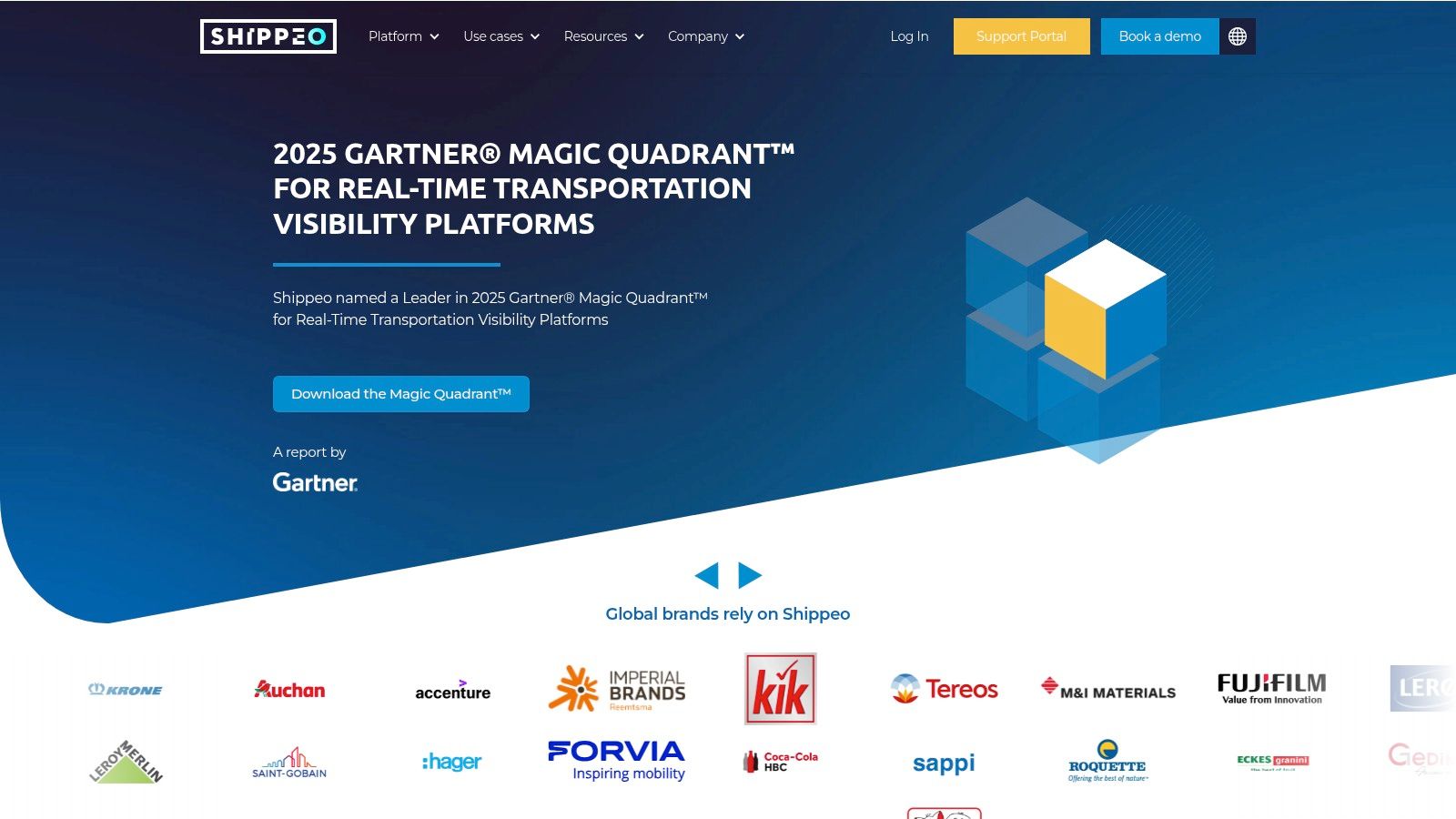
Shippeo transforms reactive problem-solving into proactive management. For example, a distribution manager can use the platform’s real-time alerts to learn of a potential late arrival for a critical inbound shipment. They can then immediately access automated exception workflows to notify the receiving warehouse and adjust labor schedules, preventing costly downtime and ensuring a smooth receiving process. This focus on collaborative exception handling is a key differentiator.
Key Information & Use Cases
Ideal User: Best for European-centric and global businesses that prioritize collaborative logistics and require accurate, machine-learning-driven ETAs for multimodal shipments.
Pricing: Custom quote-based. Pricing is tailored based on factors like shipment volume, transportation modes, and the level of carrier onboarding support required.
Implementation: Requires a structured onboarding process, particularly for carrier integration. Shippeo provides significant support to ensure high carrier adoption rates, but this can involve a dedicated project timeline.
Pros: Strong multimodal tracking capabilities; highly accurate, machine-learning-powered ETAs; excellent collaborative features for exception management.
Cons: The initial setup and carrier onboarding can be complex and time-consuming for organizations without dedicated logistics IT resources.
Visit the website: [https://www.shippeo.com/](https://www.shippeo.com/)
5. Coupa
Coupa offers a comprehensive Business Spend Management (BSM) platform that integrates supply chain design, planning, and visibility into a unified whole. While not a pure-play visibility provider, its strength lies in connecting procurement, invoicing, and expenses with supply chain operations. This approach provides a unique financial and operational perspective, making it one of the most cohesive supply chain visibility tools for companies focused on cost control and efficiency.
What sets Coupa apart is its community-powered intelligence. For example, a procurement manager can leverage insights derived from trillions of dollars in spend data to benchmark supplier performance and risk. This allows them to proactively identify potential disruptions tied to supplier health and switch to more reliable partners before an issue impacts the supply chain. Its deep integration capabilities, supporting over 160 ERPs like SAP and Oracle, ensure that visibility data informs financial and planning systems in real time.
Key Information & Use Cases
Ideal User: Best suited for C-level executives and finance/procurement leaders in mid-market to enterprise companies who want to connect supply chain visibility directly to business spend and financial outcomes.
Pricing: Custom quote-based. Pricing is determined by the specific modules selected (e.g., procurement, supply chain design, invoicing) and the scale of the deployment.
Implementation: Implementation can be time-consuming and often requires dedicated project management, particularly when integrating multiple modules across finance, procurement, and supply chain departments.
Pros: Excellent for connecting operational visibility with financial control; enhances supplier collaboration; AI-powered forecasting.
Cons: The platform's extensive feature set can have a steep learning curve; implementation can be a significant undertaking.
Visit the website: https://www.coupa.com/
6. Descartes MacroPoint
Descartes MacroPoint provides a highly connected, real-time freight visibility platform that serves shippers, brokers, and logistics service providers. Its core strength is its vast network, which combines telematics/ELD data, transportation management system integrations, and a mobile driver app to capture shipment locations. This makes it one of the most reliable supply chain visibility tools for companies that rely heavily on a diverse network of carriers for ground transportation.
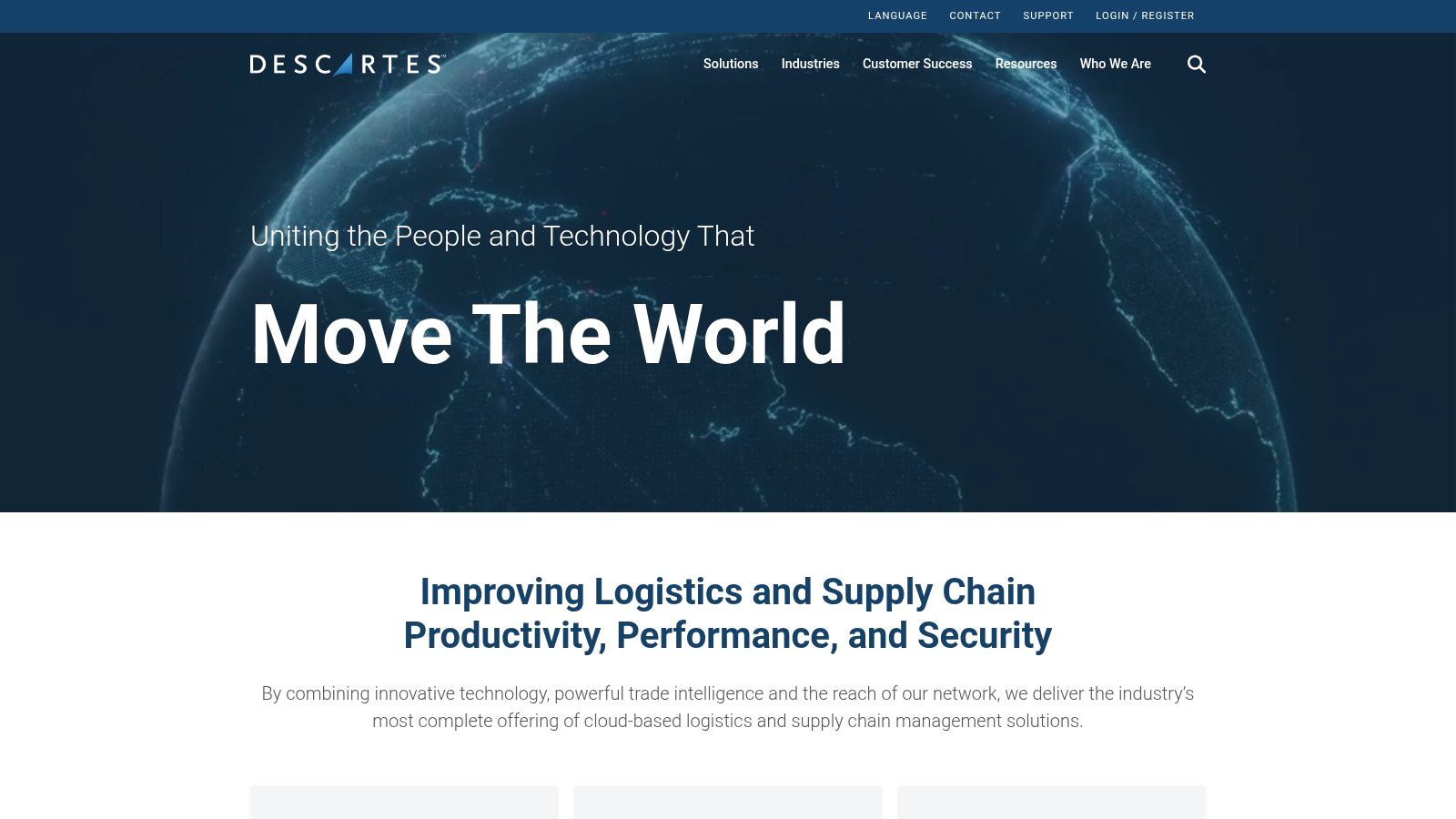
The platform excels at exception management through automated alerts and predictive analytics. For example, a third-party logistics (3PL) provider can use MacroPoint to automatically notify a customer that their shipment will be late due to an unforeseen traffic event, well before the scheduled delivery time. This proactive communication enhances customer trust and allows for immediate contingency planning, turning a potential service failure into a well-managed situation.
Key Information & Use Cases
Ideal User: Best for freight brokerages, 3PLs, and shippers who need extensive visibility across a wide network of over-the-road carriers.
Pricing: Offered on a custom, quote-based model. Pricing typically scales with the volume of shipments tracked and the level of integration required.
Implementation: Implementation can range from simple carrier onboarding to more complex integration with existing TMS or ERP platforms, often requiring some technical coordination.
Pros: Extensive carrier network; strong focus on real-time alerts and exception management.
Cons: The user interface can feel less modern than some newer competitors, and the initial setup process might be complex for smaller organizations.
Visit the website: [https://www.descartes.com/](https://www.descartes.com/)
7. Tive
Tive takes a unique hardware-centric approach to visibility, specializing in real-time tracking of not just a shipment's location but also its condition. By deploying multi-sensor trackers on individual shipments, Tive provides granular data on temperature, humidity, shock, and light exposure, making it an essential platform for high-value, sensitive, or perishable goods. This focus on in-transit integrity makes it one of the most practical supply chain visibility tools for companies where product quality is paramount.

The platform translates this sensor data into actionable alerts. For example, a pharmaceutical logistics manager can receive an immediate notification if a vaccine shipment experiences a temperature deviation, allowing them to intervene before the product is compromised. This level of proactive control is a key driver for operational excellence, aligning with strategies for improving supply chain efficiency. Tive's combination of hardware and software ensures end-to-end shipment accountability.
Key Information & Use Cases
Ideal User: Companies shipping sensitive, high-value goods like pharmaceuticals, fresh food, or electronics that require strict condition monitoring.
Pricing: Typically provided on a custom quote basis, often structured as a pay-per-shipment or tracker-as-a-service model.
Implementation: Relatively straightforward, as it can operate independently or integrate with existing TMS/ERP systems via APIs. The main process involves deploying the physical trackers.
Pros: Exceptional real-time condition monitoring; easy-to-deploy hardware.
Cons: The cost per shipment can be higher than software-only solutions, and managing the reverse logistics of reusable trackers can add complexity.
Visit the website: [https://tive.com/](https://tive.com/)
8. Zetes
Zetes specializes in providing granular, real-time insights throughout the entire delivery process, from the first mile to the last. Its core strength is a highly customizable and collaborative cloud-based data hub, which is designed to connect all stakeholders and ensure maximum production uptime and order fulfillment. This focus on process execution and collaboration makes it one of the most practical supply chain visibility tools for improving operational efficiency.

The platform empowers teams to act on live data, directly impacting key performance indicators. For example, a distribution center manager can use the Zetes platform to monitor carrier performance in real-time, identify a recurring delay with a specific provider, and immediately switch to a more reliable partner for critical shipments. This level of control helps companies consistently achieve on-time-in-full (OTIF) targets and reduce costs associated with disruptions.
Key Information & Use Cases
Ideal User: Best for manufacturers, retailers, and 3PLs focused on optimizing execution, improving supplier and carrier collaboration, and achieving high OTIF rates.
Pricing: Custom quote-based. Pricing is tailored to the specific modules required, the number of users, and the scale of the implementation.
Implementation: The process is solution-oriented and may require integration with existing WMS, TMS, and ERP systems. The initial setup can be complex depending on the level of customization.
Pros: Enhances supplier and carrier performance; improves on-time-in-full achievement; reduces costs tied to disruptions.
Cons: May require significant integration work; the initial setup might be complex for users without dedicated IT support.
Visit the website: [https://www.zetes.com/en/end-to-end-solutions/supply-chain-visibility-software](https://www.zetes.com/en/end-to-end-solutions/supply-chain-visibility-software)
9. Blue Yonder
Blue Yonder is a powerhouse in the supply chain software space, offering a suite of solutions that tightly integrate planning with execution. Its platform uses AI and machine learning to provide end-to-end visibility, moving beyond simple tracking to help businesses predict demand, identify potential disruptions, and proactively shape supply outcomes. It is one of the more comprehensive supply chain visibility tools available for businesses focused on advanced planning.
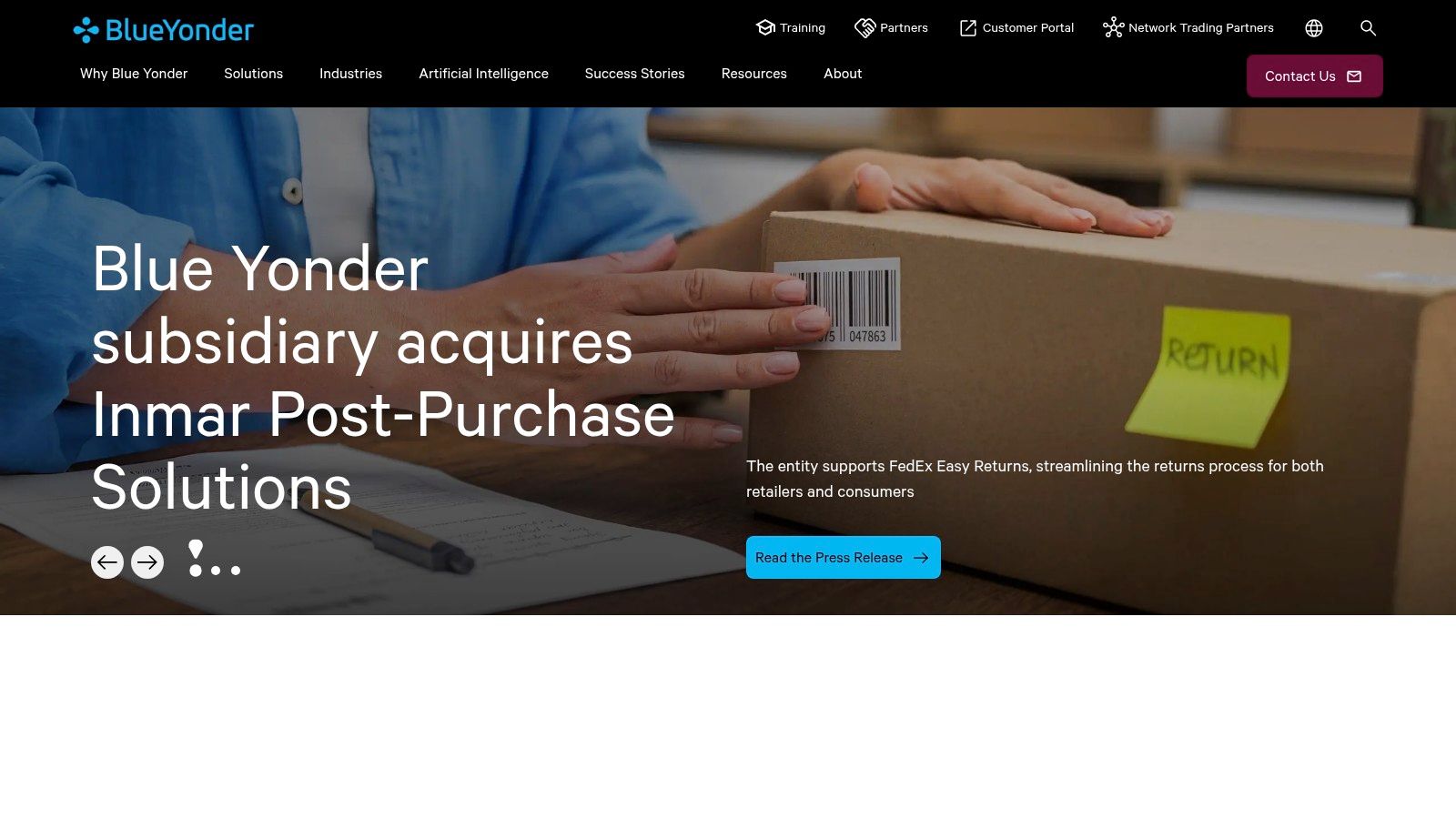
The platform’s strength is its Luminate Platform, which connects data from across the enterprise and its partner ecosystem. A retail operations manager, for instance, can use Blue Yonder's integrated planning to align inventory levels with real-time sales data from omni-channel commerce, ensuring product availability while minimizing carrying costs. This ability to link demand signals directly to supply chain execution is what sets it apart.
Key Information & Use Cases
Ideal User: Best for large manufacturing, retail, and logistics companies that need sophisticated demand forecasting and integrated business planning capabilities.
Pricing: Custom quote-based. Pricing is tailored to the specific modules deployed, user count, and scale of the operation.
Implementation: A significant undertaking that typically requires a dedicated project team and change management, as it often involves replacing or integrating with multiple legacy systems.
Pros: Deep functionality in planning and forecasting; strong AI/ML capabilities; provides actionable insights for better decision-making.
Cons: The system's complexity can be a steep learning curve and may require extensive training; implementation can be lengthy and resource-intensive.
Visit the website: [https://blueyonder.com/](https://blueyonder.com/)
10. Infor Nexus
Infor Nexus uniquely merges physical and financial supply chain processes onto a single, cloud-based network, offering visibility from procurement to payment. Its key distinction is the integration of financial services, logistics, and supplier collaboration in one place. This creates a holistic view that connects product flow with cash flow, making it one of the most comprehensive supply chain visibility tools for businesses focused on both operational and financial efficiency.
The platform excels at providing a shared version of the truth for all stakeholders, including suppliers, brokers, carriers, and financial institutions. For example, a procurement manager can track an order from the factory floor, see its progress in transit, and simultaneously view the status of the corresponding invoice and payment settlement. This connection between physical events and financial transactions helps reduce disputes, unlock working capital, and streamline the entire procure-to-pay lifecycle.
Key Information & Use Cases
Ideal User: Best for multinational corporations, particularly in retail and manufacturing, that need to manage complex global supplier networks and want to integrate financial supply chain management with logistics visibility.
Pricing: Pricing is customized based on a company's transaction volume, number of users, and the specific modules required (e.g., supply chain finance, logistics).
Implementation: The implementation process is typically extensive, requiring collaboration across finance, logistics, and IT departments to integrate with ERPs and financial systems.
Pros: Exceptional integration of physical and financial supply chains; strong network collaboration features.
Cons: Implementation can be time-consuming and complex; the extensive feature set may require significant training to master fully.
Visit the website: https://www.infor.com/products/nexus
11. Anvyl
Anvyl specializes in the upstream part of the supply chain, offering a platform that centers on supplier collaboration and production visibility. It excels at unifying communication, automating order management, and providing a clear window into the manufacturing process, from sourcing raw materials to final product assembly. This focus makes it one of the more unique supply chain visibility tools, particularly for brands that design and manufacture their own physical products.
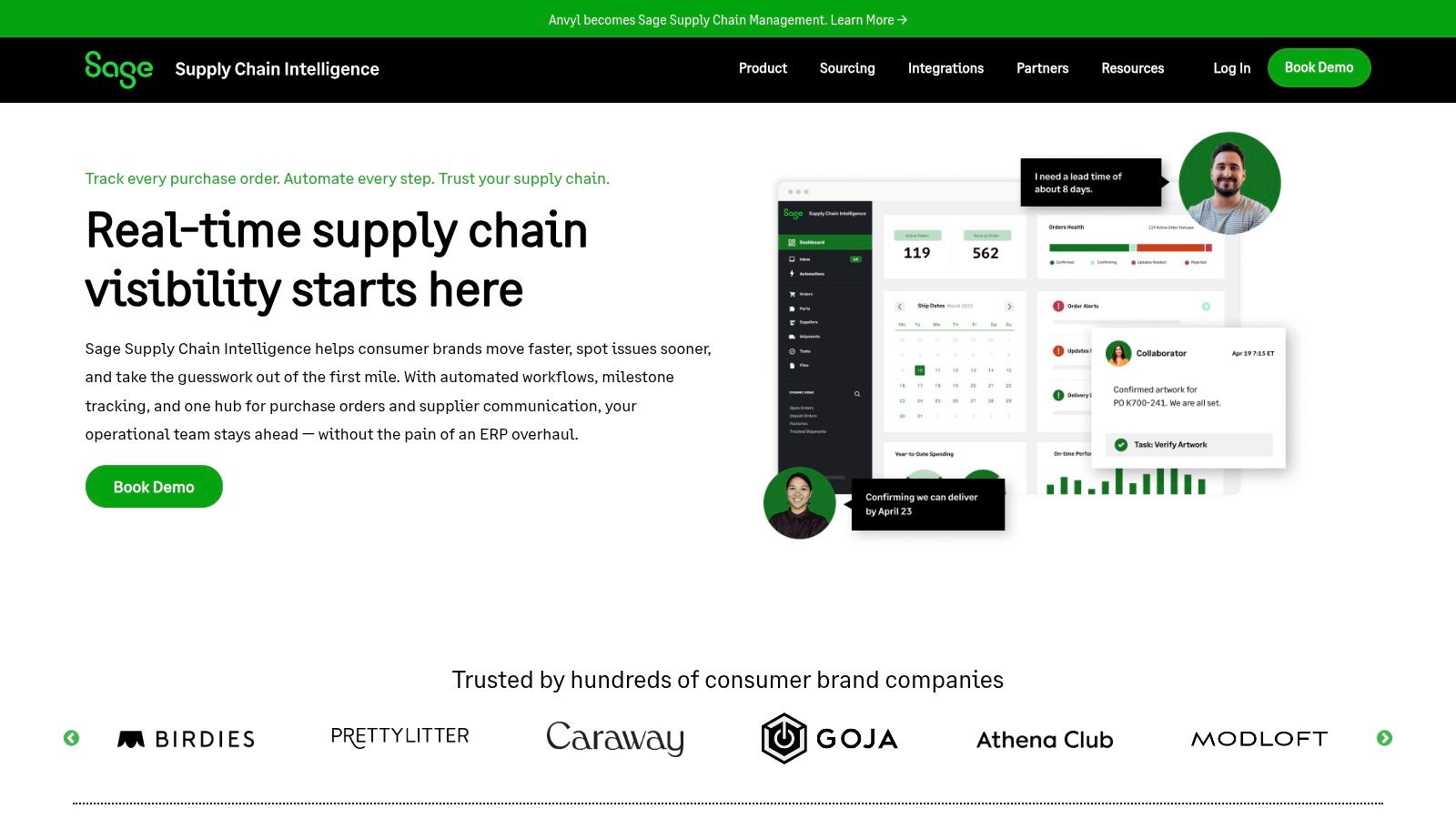
Its core value is in streamlining the pre-shipment lifecycle. For example, a product manager can use Anvyl to issue purchase orders, receive real-time production status updates directly from the factory floor, and manage quality assurance milestones all in one place. This centralized control helps manage supplier performance, a key component of effective vendor relationship management best practices.
Key Information & Use Cases
Ideal User: Best for consumer brands, direct-to-consumer (DTC) companies, and businesses that manage complex production cycles with multiple overseas or domestic suppliers.
Pricing: Custom quote-based. Pricing typically depends on the number of users, purchase order volume, and required integrations.
Implementation: The setup involves onboarding suppliers to the platform, which requires clear communication and training. Integration with existing ERP or accounting software is common.
Pros: Excellent for improving supplier communication and tracking production milestones; automates manual sourcing and PO tasks.
Cons: Less focused on in-transit logistics compared to other platforms; supplier adoption can be a potential hurdle.
Visit the website: [https://anvyl.com/](https://anvyl.com/)
12. Kinaxis
Kinaxis distinguishes itself by merging supply chain planning with execution through its concurrent planning technique. This platform provides real-time visibility not just into what's happening now, but how disruptions will impact future plans, allowing businesses to run multiple what-if scenarios instantly. This makes it one of the most strategic supply chain visibility tools for companies that need to align long-range planning with day-to-day operational realities.
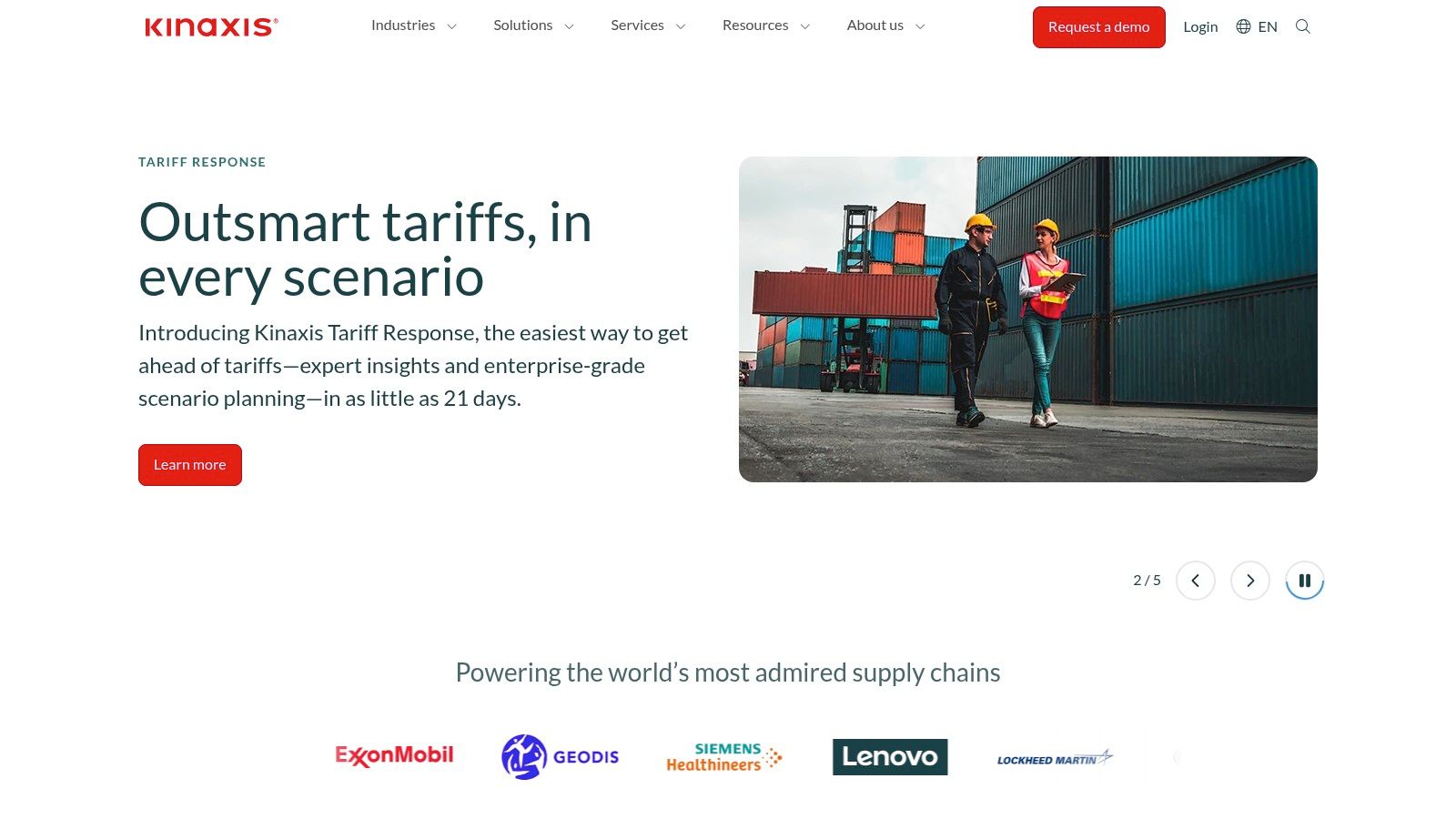
Its core strength is in creating a single, integrated environment where planning, monitoring, and responding happen simultaneously. For example, a demand planner can see the impact of a sudden supplier shortage on production schedules and delivery commitments in real time. They can then model different responses, like expediting materials from an alternate supplier or reallocating inventory, and immediately push the optimal decision into execution, minimizing disruption across the entire value chain.
Key Information & Use Cases
Ideal User: Best for manufacturing and retail enterprises that require tight integration between strategic planning (S&OP, demand, supply) and operational execution.
Pricing: Custom quote-based. Pricing is tailored to the specific applications required, user count, and overall scope of the deployment.
Implementation: A comprehensive implementation is necessary, often involving significant change management and process re-engineering to leverage the concurrent planning model effectively.
Pros: Powerful scenario modeling; enhances forecasting and supply chain efficiency; provides actionable, forward-looking insights.
Cons: Implementation can be time-consuming, and the platform’s advanced capabilities may require dedicated training to fully utilize.
Visit the website: [https://www.kinaxis.com/](https://www.kinaxis.com/)
Top 12 Supply Chain Visibility Tools Comparison
Platform | Core Features & Capabilities | User Experience & Quality ★★★★☆ | Value & Pricing 💰 | Target Audience 👥 | Unique Selling Points ✨ |
|---|---|---|---|---|---|
project44 | Real-time multimodal tracking, predictive analytics, integrations | High operational efficiency, reduces costs | Medium - enterprise focused | Large logistics & supply chain teams | Seamless multi-transport visibility 🏆 |
FourKites | Predictive ETA, risk monitoring, TMS/ERP integration | Trusted by 50%+ Fortune 500, strong delivery rates | Medium-high | Large enterprises & Fortune 500 | ML-driven ETA & proactive risk management ✨ |
GoComet | AI-powered shipment tracking, workflow automation | User-friendly UI, responsive support | Medium | Logistics managers seeking automation | Simplified shipment management & AI insights |
Shippeo | Predictive visibility, exception management | Strong exception handling, multimodal support | Medium-high | Global supply chains | Exception mitigation & ML-powered insights |
Coupa | Spend management, AI demand forecasting, ERP integration | Enhances spend control & supplier collaboration | High | Procurement & finance teams | Broad ERP integrations & spend visibility |
Descartes MacroPoint | Freight tracking, predictive analytics, automated alerts | Actionable insights, improves delivery | Medium | Shippers, brokers, logistics providers | Automated exception alerts & freight focus |
Tive | Shipment location & condition tracking, actionable insights | Detailed shipment condition data | Medium | Supply chain & logistics visibility teams | Real-time shipment condition insights |
Zetes | Real-time delivery insights, cloud-based collaboration hub | Improves on-time-in-full, cost reduction | Medium-high | Stakeholders in delivery processes | Customizable cloud interface & collaboration |
Blue Yonder | Demand & supply planning, AI-powered forecasting | Enhances forecasting accuracy & planning | High | Enterprises focused on forecasting | Omni-channel commerce support & AI insights |
Infor Nexus | End-to-end supply chain & financial process visibility | Improves efficiency, predictive insights | High | Enterprises needing integrated visibility | Merges physical & financial supply chains |
Anvyl | Sourcing, production visibility, supplier collaboration | Automates workflows, improves team communication | Medium-high | Sourcing & production teams | Real-time production analytics & supplier portal |
Kinaxis | Planning-execution integration, advanced analytics | Actionable insights, efficiency-focused | High | Enterprises emphasizing planning & execution | Integrated real-time supply chain analytics |
From Visibility to Velocity: The Future is Automated
Navigating the complex landscape of modern logistics requires more than just a map; it demands a live, intelligent GPS. This extensive review has navigated through twelve of the industry's leading supply chain visibility tools, from comprehensive global platforms like project44 and FourKites to specialized solutions like Tive for in-transit tracking and Anvyl for supplier relationship management. We've seen how each platform offers a unique approach to dissolving operational silos and bringing clarity to once-opaque processes.
The central takeaway is clear: achieving real-time visibility is the foundational step, not the final destination. The true competitive advantage emerges when this newfound clarity is converted into actionable intelligence and, ultimately, automated execution. Tools like Blue Yonder and Kinaxis demonstrate that the future lies in connecting visibility with planning and response, creating a self-correcting system that can anticipate and mitigate disruptions before they escalate.
Making Your Selection: A Strategic Approach
Choosing the right platform from this list is a critical strategic decision. Your selection process should be guided by a clear understanding of your most pressing operational challenges.
For Global, Multi-Modal Complexity: If your operations span continents and involve ocean, air, and road freight, giants like project44, FourKites, and Shippeo offer the most extensive carrier networks and deep data integrations necessary for true end-to-end tracking.
For Procurement and Supplier Focus: If your primary pain points are in sourcing, supplier communication, and production tracking, platforms like Anvyl and Coupa provide specialized tools that bring visibility to the first mile of your supply chain.
For In-Transit Security and Condition Monitoring: For high-value or sensitive goods, hardware-centric solutions from Tive or Zetes offer granular, real-time data on location, temperature, and shock, providing an unmatched layer of security and quality control.
Beyond Implementation: Achieving True Integration
Successfully implementing one of these supply chain visibility tools is a significant achievement, but the work doesn't stop there. The ultimate goal is to weave this data into the very fabric of your business operations. This means integrating visibility data with your ERP, WMS, and TMS to automate workflows. For instance, a delay alert from Descartes MacroPoint shouldn't just trigger an email; it should automatically update inventory ETAs in your ERP, notify the receiving warehouse, and even adjust production schedules.
Furthermore, this automated approach extends beyond logistics into other critical business functions. The data collected from these platforms provides a rich source of insight for proactive risk mitigation. By analyzing historical transit times, route performance, and carrier reliability, companies can move towards transforming risk management through automation, creating more resilient and predictable supply chains. The future is not just about seeing problems; it's about building systems that automatically solve them.
Ready to bridge the gap between visibility and action? While these platforms provide the data, Flow Genius builds the automated workflows that act on it. Connect your new visibility tool to your CRM, ERP, and communication apps to instantly orchestrate responses to delays, automate stakeholder notifications, and create a truly autonomous supply chain with Flow Genius.